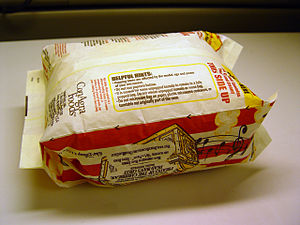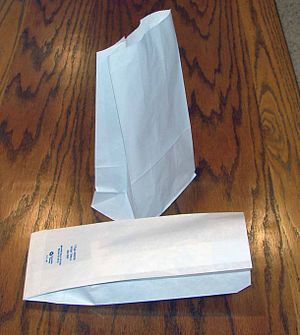- Microwave popcorn bag
-
A microwave popcorn bag is an engineered, enhanced, sealed paper bag in which un-popped popcorn is sold for the purpose of cooking popcorn in a microwave oven. These bags and their contents are sometimes referred to as microwave popcorn. In addition to the dried corn the bags typically contain solidified oil, one or more seasonings (often salt), and/or natural or artificial flavorings.
A popcorn bag may also refer to the sorts of decorated paper bags that fresh popped popcorn is sometimes sold in.
Contents
Design
The bag is typically partially folded when it is placed in a microwave, and inflates as a result of steam pressure from the heated kernels.
The design of a microwave popcorn bag is specifically keyed to avoid popped kernel scorching, an undesirable effect that takes place when popped kernels are heated above 300 °F (149 °C).[1]
A susceptor, usually a metallised film laminated onto the paper of the bag, absorbs microwaves and concentrates heat at the film interface, thus ensuring a heat distribution focused on the hard-to-heat flavor coating so that the unpopped kernels are evenly coated prior to popping, thereby ensuring even flavor throughout the product.
An early susceptor popcorn bag design was patented by the American company General Mills in 1981 (US Patent #4,267,420).[2]
Safety issues
Care in package design is needed for food safety.[3]
One danger of the microwave popcorn bag is that after one use the susceptor typically "will lose its ability to safely react to microwave energy. If it is reheated, the changes in the susceptor can cause it to burn.[citation needed]
In 2006, concerns were raised about the levels of perfluorooctanoic acid (PFOA, a chemical related to Teflon) in popcorn bags. When opening the popcorn bag directly to the face, it is possible to uptake harmful levels over time. The high temperatures used in popping popcorn may facilitate the transfer of the chemical, which is carcinogenic in lab animals, into the popcorn oil. DuPont has agreed to eliminate almost all use of the chemical by 2015.[citation needed]
Home-made alternatives
Concerned with the above issues people have been making their own popcorn bags from simple paper bags,[4] or popping the popcorn in the microwave in other containers including large glass bowls with heavy, but not airtight glass lids. Both of these home made approaches remove the threat of exposure to artificial flavoring and PFOA, but have a chance of leaving some corn kernels unpopped due to randomness of the microwave radiation distribution in a microwave. However, it is possible to cook the unpopped kernels a second time.
See also
- Kettle corn the sweet popcorn that is also sold in microwave versions
- Popcorn maker
Notes
- ^ "(WO/2001/053167) MICROWAVE FOOD PACKAGE". IP Services > PATENTSCOPE > Patent Search. WIPO. http://www.wipo.int/cgi-pct/guest/getbykey5?KEY=01/53167.010726&ELEMENT_SET=DECL.
- ^ Brastad, William A. (May 12, 1981). "Packaged food item and method for achieving microwave browning thereof (Assignee: General Mills, Inc.)". Google Patents Search. http://www.google.com/patents?vid=USPAT4267420&printsec=abstract.
- ^ Begley, T. H.; Dennison, Hollifield (1990). "Migration into food of polyethylene terephthalate (PET) cyclic oligomers from PET microwave susceptor packaging". Food Aditives and Contaminants 7 (6): 797-803. http://www.tandfonline.com/doi/abs/10.1080/02652039009373941#preview. Retrieved 29 Oct 2011.
- ^ "Microwave Popcorn: Home made, cheap and easy". http://www.instructables.com/id/Microwave-Popcorn:-Home-made,-cheap-and-easy/.
References
Wikimedia Foundation. 2010.



